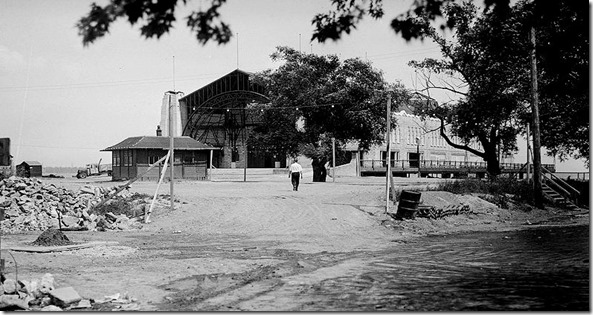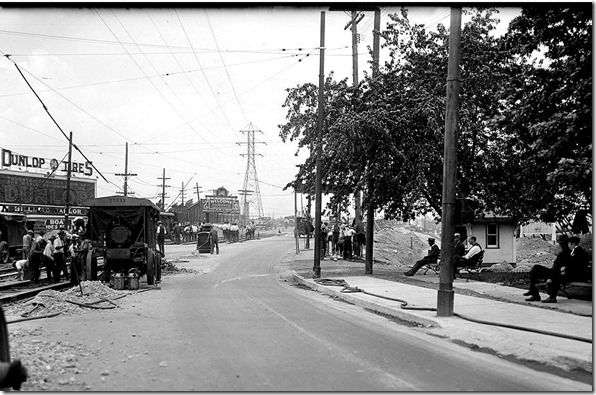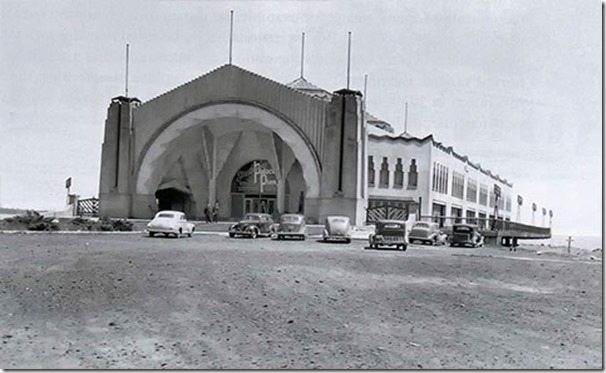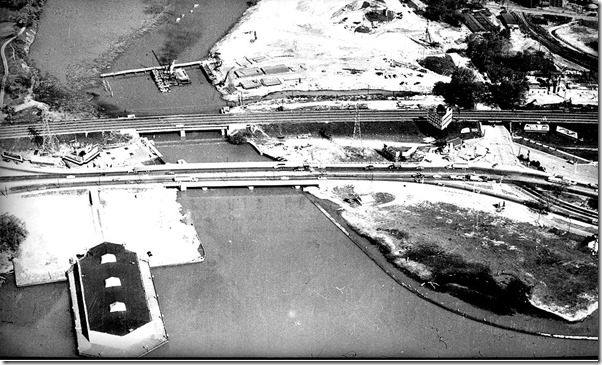The Palace Pier Ballroom and Amusement Centre, depicted on a 1930s postcard.
My memories of the Palace Pier, an immense structure that extended 300 feet into Lake Ontario, date from the days of World War 11. On hot summer days in the 1940s, when my parent took my brother and me to Sunnyside beach to paddle in the cold waters of the lake, I gazed at its enormous size, as it dominated the scene to the west of Sunnyside Beach. I asked my mother about it, and she dismissed it as a place where people of “dubious” character attended, as it was a “dance hall.” My father gave an amused smile as if he seemed to disagree with her assessment, but said nothing. He had played a trumpet in McCormick’s Dance Band during the 1930s, before he met my mother, and had a more liberal view of dance halls.
A year or two later, I learned what the word “dubious” implied and discovered that my father thought that to dismiss Palace Pier as a mere dance hall was do it a great injustice. Located on the west bank of the Humber River, there were no other buildings in the area that competed with it in size. In its heyday, it was one of the most spectacular dance spots in Toronto. However, when I was a boy, I was too young to know about the famous entertainers who were featured there or to appreciate its importance in the night life of the city. Also, it was another few years before I became unaware of the inherent attraction of “dubious” places.
The Palace Pier was conceived in 1927 by the Provincial Improvement Corporation. It was inspired by the wonderful seaside piers in Great Britain, such as those in Brighton, one of which survives today. Toronto’s pier was to be a “year-round amusement enterprise.” Sunnyside Beach, which opened in 1921, had been a great success and the Palace Pier was an attempt to improve Toronto’s lakeside area by extending development further west along the shoreline. In some respects, it was a project similar to Ontario Place, which was constructed to celebrate Canada’s Centennial in 1967. It too was built out over the water, although it was created by dumping landfill into Lake Ontario. Similar to Palace Pier, it was an amusement centre and contained a theatre—Cinesphere.
Palace Pier was to have four buildings, each 260 feet in length, one of them containing a ballroom and another, a Palace of Fun. The latter was to have shops, an arcade, games, restaurants, and food kiosks. There was to be a 1500-seat theatre and a 170-foot bandstand. When the covered walkways and promenades were added to the sides of it, the structure would extend over a third of a mile into the lake. At its southern end there was to be a steamboat landing, as the 1920s was an era when leisure travel on Lake Ontario was highly popular. It was envisioned that over 3000 couples would dance the night away its ballroom, in a multifunctional facility that could also be used for roller skating and bowling.
Artist’s sketch of the proposed Palace Pier employed to promote its construction and attract investors. Sketch from Toronto Sun, Jan. 10, 2016, contained in an article by Mike Filey.
Palace Pier was designed in the Moroccan style by Craig and Madill, a Toronto company that was later to design the CNE Bandshell. However, by the time the pier transitioned from the architects’ drawing boards to the construction site, the Great Depression had descended, necessitating that the plans be greatly reduced. Only the first phase of the structure was to proceed, and due to delays, its corner stone was not laid by former Prime Minister Arthur Meighen until 1931. It extended out into the lake 300 feet and contained the main ballroom. Unfortunately, it was the only part of the original grand plans that ever materialized, and even after it was completed, it stood empty for a decade due to the financial restraints of the times. When it finally opened on June 18, 1941, it was a roller rink named Strathcona Palace Pier, another site of the Strathcona rink on Christie Street, south of St. Clair Avenue. I attended this rink when I was a teenager.
The pier’s 19-foot wide boardwalks, located on the east and west sides of it, provided commanding views of the lake. On the east side, the city’s skyline was visible. Its inaugural event was a fundraiser for the British victims of the bombing by the Nazi’s, the headliner for the event the Hollywood star, Bob Hope. He was in Toronto to promote his latest film, “Caught in the Draft.”
In 1943, the pier reverted to its original purpose and became the Queensway Ballroom, and later the Humber Pier Ballroom. During the years of World War 11, some of the famous “big bands” performed at the it—Lionel Hampton, Artie Shaw, Less Brown, Duke Ellington, the Dorsey Brothers, Louis Armstrong, Harry James and Stan Kenton.
It was renovated in the 1950s and reverted to its original name, the “Palace Pier.” It was one of the few surviving large-scale dance floors in the city. In the mid-1950s, it included country acts such as Johnny Cash and Patsy Cline. As attendance slowly dwindled, on weeknights, the pier held bingo events and rented its space for private functions such as political rallies, boxing matches, high school dances, and year-end proms.
However, its life came to an end on January 7, 1963 when it was torched, the arsonist never caught. The structure was destroyed to the extent that it required complete rebuilding, which was not financially practical. It was demolished and the great pier disappeared forever.
On the site of the pier, two luxury condominium towers and public park were constructed, which were named after the famous amusement facility. The north tower was built in 1978 and the south tower in 1991. A monument, donated by the residents of the condominium, was erected to commemorate the original Palace Pier. It was placed on the west side of the footbridge across the Humber River. The monument had originally been one of the cement footings that had been used in the pier’s construction.
Sources: www.torontovintagesociety.ca—vintagesocity.ca—ww.blogto.com—tornontohistory.net—citiesintime.ca/toronto—urbantoronto.ca/news—https://booksgoogle.ca/books—www.torontosun.com
Location of the Palace Pier Dancehall, beside lake Ontario, on the west side of the Humber River.
Entrance to the Palace Pier on July 29, 1931, when it was under construction. Toronto Archives, S 0372, SS 0034, Item 0070.
Looking west on the Lakeshore Road, the facade of the Palace Pier visible in the background, to the left of the tall hydro tower. Pictures was taken on August 4, 1931, while the building was under construction. Toronto Archives, S. 032, SS 5500, Item 0078.
Undated photo of the Palace Pier, the view showing the north and east facades. The covered walkway and terrace on the east side can be seen.
Palace Pier in the 1940s, the north and west facades visible.
View looking south toward Lake Ontario in 1954, when the bridge over the Humber River was being constructed. The Palace Pier is in the background. Toronto Public Library, r- 3136.
Aerial view of the area surrounding the Palace Pier in 1958. The pier is in the bottom left-hand corner of the photo, on the west bank of the Humber River. The widened Lakeshore Road is to the north of the pier, the Gardiner Expressway to the north of it. Toronto Archives, S 0065, File 0047, Id. 0011.
The Palace Pier after being ravaged by fire in January 1963. Photo from the Toronto Star, Baldwin Collection, Toronto Public Library tspt 000344f.
To view the Home Page for this blog: https://tayloronhistory.com/
A link to view posts that explore Toronto’s Heritage Buildings:
https://tayloronhistory.com/2014/01/02/canadas-cultural-scenetorontos-architectural-heritage/
A link to view previous posts about the movie houses of Toronto—historic and modern.
The publication entitled, “Toronto’s Theatres and the Golden Age of the Silver Screen,” was written by the author of this blog. It explores 50 of Toronto’s old theatres and contains over 80 archival photographs of the facades, marquees and interiors of the theatres. It relates anecdotes and stories by the author and others who experienced these grand old movie houses.
To place an order for this book:
Book also available in Chapter/Indigo, the Bell Lightbox Book Shop, and by phoning University of Toronto Press, Distribution: 416-667-7791 (ISBN 978.1.62619.450.2)
Another book, published by Dundurn Press, containing 80 of Toronto’s old movie theatres will be released in the spring of 2016. It is entitled, “Toronto’s Movie Theatres of Yesteryear—Brought Back to Thrill You Again.” It contains over 125 archival photographs.
A second publication, “Toronto Then and Now,” published by Pavilion Press (London, England) explores 75 of the city’s heritage sites. This book will also be released in the spring of 2016.
![palace-pier-dance-hall[1].png palace-pier-dance-hall[1].png](https://tayloronhistory.com/wp-content/uploads/2016/02/palace-pier-dance-hall1-png_thumb.jpg)
![1297791972217_ORIGINAL[1] 1297791972217_ORIGINAL[1]](https://tayloronhistory.com/wp-content/uploads/2016/02/1297791972217_original1_thumb.jpg)
![data=RfCSdfNZ0LFPrHSm0ublXdzhdrDFhtmHhN1u-gM,Bcp1Jl2WTHd5fqTIEjV_zN1J8UEcfCtEi_ZvqTNN6q2fWfUOXVRASZFmb_v-HdAaljOkWtU4RufMioB_IcOyE-lt5-ZtuDAvHUQte2m[1].png data=RfCSdfNZ0LFPrHSm0ublXdzhdrDFhtmHhN1u-gM,Bcp1Jl2WTHd5fqTIEjV_zN1J8UEcfCtEi_ZvqTNN6q2fWfUOXVRASZFmb_v-HdAaljOkWtU4RufMioB_IcOyE-lt5-ZtuDAvHUQte2m[1].png](https://tayloronhistory.com/wp-content/uploads/2016/02/datarfcsdfnz0lfprhsm0ublxdzhdrdfhtmhhn1u-gmbcp1jl2wthd5fqtiejv_zn1j8uecfctei_zvqtnn6q2fwfuoxvras1.jpg)


![Palace_Pier_Plaque_2[1] Palace_Pier_Plaque_2[1]](https://tayloronhistory.com/wp-content/uploads/2016/02/palace_pier_plaque_21_thumb.jpg)

![1954, bridge over Humber pictures-r-3136[1] 1954, bridge over Humber pictures-r-3136[1]](https://tayloronhistory.com/wp-content/uploads/2016/02/1954-bridge-over-humber-pictures-r-31361_thumb.jpg)

![TRL, 1963 tspa_0000344f[1] TRL, 1963 tspa_0000344f[1]](https://tayloronhistory.com/wp-content/uploads/2016/02/trl-1963-tspa_0000344f1_thumb.jpg)
![cid_E474E4F9-11FC-42C9-AAAD-1B66D852[2] cid_E474E4F9-11FC-42C9-AAAD-1B66D852[2]](https://tayloronhistory.com/wp-content/uploads/2016/02/cid_e474e4f9-11fc-42c9-aaad-1b66d8522_thumb2.jpg)


Great info. I need to correct you on the photo captioned “looking west on lakeshore road” , Toronto Archives, S. 032, SS 5500, Item 0078.
The object you’re referring to is actually a steel bridge over the Humber River, not the Palace Pier. It was removed sometime around 1931. From that vantage point I believe the ballroom would have been just out of frame to the right of the photo.
Cheers!
This is incredible. All of which has inspired me to create a render of this amazing place. Perhaps it will light a fire under some people who might have the power to create a Version 2. 🙂